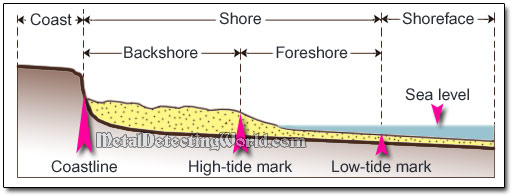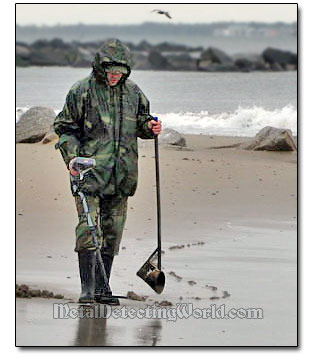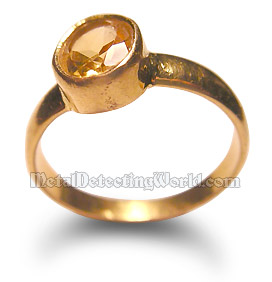Types of Metal Detecting Activities, page 20:
WET SAND BEACH HUNTING
(CONTINUED from previous page)
The Most Productive Spots on Wet Sand and in Shallow Surf
1) A strip, 20 feet wide, which runs parallel to the waterline and is centered on a middle point of the intertidal zone (or littoral zone) - the area of the sea floor that lies between the high- and low-tide marks. This strip should be searched during low tides and in a zigzag pattern for better results. Even if you miss a few gold items, you will find other ones during your next visit. The next storm will replenish the valuables, move them around, and possibly bring the deep ones closer to surface; thus, making them detectable.

2) Coin and gold jewelry "pockets" which are more likely to occur in the intertidal zone than on the dry sand beach. This is because the gold items sink through the sand and find deep spots on the hard clay layer or rock-bottom quicker in the constantly moving environment of the surf than on the less active dry beach.
Basic Searching Technique
Once you find a pocket of valuables, you should stay in that area and investigate it thoroughly. This is not as important on the dry beach as down by the low-tide mark. The rule is simple: anytime you start digging coins, it means you are in a productive area, and you will have to dig up all coins before finding the deeper and heavier gold rings.


Old coins are the best indicator for the presence of gold jewelry at the spot. Gold items are less likely to emit strong and solid signals. That is why you should carefully listen to and certainly investigate the "whispering" or faint signals - the signals of the gold rings buried deep. When you receive such a signal, concentrate and scan the spot from different directions, holding the search coil with various angles.
If you are finding only trash - pull-tabs, screw cups, foil, aluminum pieces and bottle caps, you need to go further away from the shore because most of the trash items are accumulated closer to the surf line. If you are not receiving any good solid signals, focus on small and faint ones which are more likely to be small treasures left by other detectorists.
On wet sand, lower sensitivity settings on your metal detector will reduce the amount of false signals or completely eliminate them. You should not be afraid to reduce sensitivity because by being able to work with "smoothed out" audio, you will be able to hear many "tiny" signals and increase your finds rate.
Sometimes, while wading in shallow surf, a beach hunter is experiencing difficulty in pinpointing a target that is moved by the current. Most likely such a target is a pull-tab. They are swept away by the current easily, a gold ring will not do this.
Also maintain the search coil discipline by swinging the coil in tight and overlapping manner. Do not allow the coil to touch the sand's surface - keep it flat and level and about an inch (2-3 cm) from the wet surface.